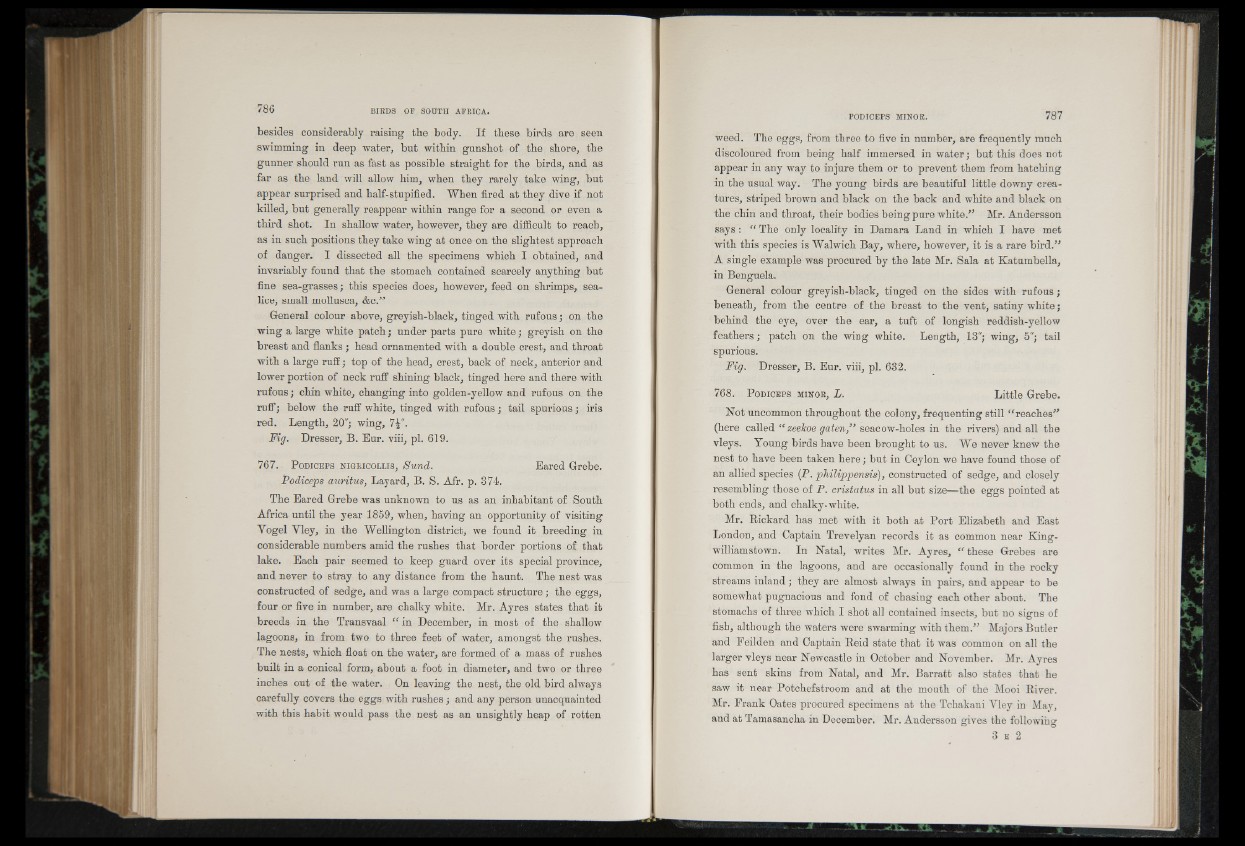
besides considerably raising the body. If these birds are seen
swimming in deep water, but within gunshot of the shore, the
gunner should run as fast as possible straight for the birds, and as
far as the land will allow him, when they rarely take wing, but
appear surprised and half-stupified. When fired at they dive if not
killed, but generally reappear within range for a second or even a
third shot. In shallow water, however, they are difficult to reach,
as in such positions they take wing at once on the slightest approach
of danger. I dissected all the specimens which I obtained, and
invariably found that the stomach contained scarcely anything but
fine sea-grasses; this species does, however, feed on shrimps, sea-
lice, small mollusca, &c.”
General colour above, greyish-black, tinged with rufous; on the
wing a large white patch; under parts pure white; greyish on the
breast and flanks; head ornamented with a double crest, and throat
with a large ruff ; top of the head, crest, back of neck, anterior and
lower portion of neck ruff shining black, tinged here and there with
rufous; chin white, changing into golden-yellow and rufous on the
ruff; below the ruff white, tinged with rufous; tail spurious; iris
red. Length, 20"; wing, 7^".
Fig. Dresser, B. Eur. viii, pi. 619.
767. P odice ps n igb ico l l is , Sund. Eared Grebe.
Podiceps auritus, Layard, B. S. Afr. p. 374.
The Eared Grebe was unknown to us as an inhabitant of South
Africa until the year 1859, when, having an opportunity of visiting
Vogel Vley, in the Wellington district, we found it breeding in
considerable numbers amid the rushes that border portions of that
lake. Each pair seemed to keep guard over its special province,
and never to stray to any distance from the haunt. The nest was
constructed of sedge, and was a large compact structure; the eggs,
four or five in number, are chalky white. Mr. Ayres states that it
breeds in the Transvaal “ in December, in most of the shallow
lagoons, in from two to three feet of water, amongst the rushes.
The nests, which float on the water, are formed of a mass of rushes
bnilt in a conical form, about a foot in diameter, and two or three
inches out of the water. On leaving the nest, the old bird always
carefully covers the eggs with rushes; and any person unacquainted
with this habit would pass the nest as an unsightly heap of rotten
weed. The eggs, from three to five in number, are frequently much
discoloured from being half immersed in water; but this does not
appear in any way to injure them or to prevent them from hatching
in the usual way. The young birds are beautiful little downy creatures,
striped brown and black on the back and white and black on
the chin and throat, their bodies being pure white.” Mr. Andersson
says : “ The only locality in Damara Land in which I have met
with this species is Walwich Bay, where, however, it is a rare bird.”
A single example was procured by the late Mr. Sala at Katumbella,
in Benguela.
General colour greyish-black, tinged on the sides with rufous;
beneath, from the centre of the breast to the vent, satiny white;
behind the eye, over the ear, a tuft of longish reddish-yellow
feathers; patch on the wing white. Length, 13"; wing, 5"; tail
spurious.
Fig. Dresser, B. Eur. viii, pi. 632.
768. P o dic e ps m ino r, L. Little Grebe.
Not uncommon throughout the colony, frequenting still “ reaches”
(here called “ zeeJcoe gaten,” seacow-holes in the rivers) and all the
vleys. Young birds have been brought to us. We never knew the
nest to have been taken here; but in Oeylon we have found those of
an allied species (P. philippensis), constructed of sedge, and closely
resembling those of P. cristatus in all but size—the eggs pointed at
both ends, and chalky-white.
Mr. Rickard has met with it both at Port Elizabeth and East
London, and Captain Trevelyan records it as common near King-
williamstown. In Natal, writes Mr. Ayres, “ these Grebes are
common in the lagoons, and are occasionally found in the rocky
streams inland; they are almost always in pairs, and appear to be
somewhat pugnacious and fond of chasing each other about. The
stomachs of three which I shot all contained insects, but no signs of
fish, although the waters were swarming with them.” Majors Butler
and Feilden and Captain Reid state that it was common on all the
larger vleys near Newcastle in October and November. Mr. Ayres
has sent skins from Natal, and Mr. Barratt also states that he
saw it near Potchefstroom and at the mouth of the Mooi River.
Mr. Frank Oates procured specimens at the Tchakani Vley in May,
and at Tamasancha in December. Mr. Andersson °g ives the followinOg
3 e 2